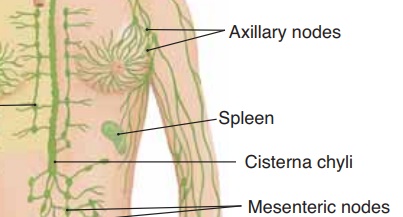Chapter: Essentials of Anatomy and Physiology: The Lymphatic System and Immunity
Spleen

SPLEEN
The spleen is located in the upper left quadrant of the abdominal cavity, just below the diaphragm, behind the stomach. The lower rib cage protects the spleen from physical trauma (see Fig. 14–3).
In the fetus, the spleen produces red blood cells, a function assumed by the red bone marrow after birth. After birth the spleen is very much like a large lymph node, except that its functions affect the blood that flows through it rather than lymph.
The functions of the spleen after birth are:
1. Contains plasma cells that produce antibodies to foreign antigens.
2. Contains fixed macrophages (RE cells) that phago-cytize pathogens or other foreign material in the blood. The macrophages of the spleen also phago-cytize old red blood cells and form bilirubin. By way of portal circulation, the bilirubin is sent to the liver for excretion in bile.
3. Stores platelets and destroys them when they are no longer useful.
The spleen is not considered a vital organ, because other organs compensate for its functions if the spleen must be removed. The liver and red bone marrow will remove old red blood cells and platelets from cir-culation. The many lymph nodes and nodules will phagocytize pathogens (as will the liver) and have lym-phocytes to be activated and plasma cells to produce antibodies. Despite this redundancy, a person without a spleen is somewhat more susceptible to certain bac-terial infections such as pneumonia and meningitis.

Related Topics